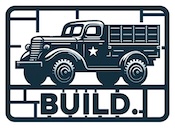As you may know if you follow this blog, I have a certain obsession with learning all I can about insulation foam. Yeah, we all have our nerd lusts.
When I started working on my latest project, the Model T vignette, I played around with a few materials to build the vignette base. Here are some thoughts on my findings.
Foam sealer/texturizer
Deluxe Materials Foam Armour
Thick water based resin that sets to produce an attractive, durable, scratch resistant coating on foam to prevent dings, wear and disintegration. It dries to a surface that can be painted and glued easily and will reduce damage.
This stuff brushed/spread on clear and has a bit of a rubbery texture when dry. I gently sanded it and was surprised it actually sanded. I didn’t expect it to be that hard. As you can see in the picture, there was some waviness to it, but not much. (Both images were only lightly sanded) I can easily see it being used on the sides of your insulation foam instead of things like styrene or wood veneer to provide a nice edge.
AK Interactive Foam Texturizer
Foam Sealer is a fine paste intended for sealing any type of foam. This paste does not damage the foam and protects it from subsequent aggressive processes. It is an acrylic product, so you can dilute it with water and clean your tools easily.
This material felt more like a drywall joint compound. Heavier, thicker, and more likely to ding (I’m guessing) than the Foam Armour. It sands like joint compound but isn’t as “dusty”. I’d be more likely to use this than joint compound, but the two don’t feel that far off. Laid down pretty easy with a spatula and as you can also see, sands pretty easily.
Concrete finish
AK Interactive Concrete Texture
Scale concrete texture in a grey shade similar to that of concrete buildings and runways. Acrylic product for textures in dioramas. Perfect results in thin or thick layers. It can be diluted with water or an acrylic thinner to improve its flow.
I really liked this and end up using it on my Model T vignette. The grain is super consistent throughout (which is both good and bad), but spread very easily. It was also very easy to smooth away the spatula marks, and seems to have self-leveled a bit while drying. Once it was dry, it felt very hard… not as semi-rubbery as the Mig product below. When it dried, I lightly sanded parts of it with a sanding board which knocked down the texture and made it look more realistic.
Mig Ammo Concrete
The product features an acrylic base, which makes it easy to use and clean-up is simple. It can be applied to both large and small surfaces.
This material was easy to spread on but definetnely had more trouble laying down a smooth, realistic finish. I might want to try again and add some water over the top once applied to smooth it out, or to thin the material with water before laying it down at all. The grain of the material felt less consisent, which isn’t a bad thing.
Glueing foam
I’ve been on a search for a decent foam glue since I first started using the foam. Gluing foam together is surprisingly tough (don’t forget to cut off the plastic protective coating!) and results have only been marginal. Until I discovered Aleene’s Tacky Glue. I tested three types for glueing wood veneer to foam. I’ve tried a number of glues in the past, including wood glue and white glue. These were both too “wet” and caused problems with warping the basswood, pine, and walnut veneers. Tacky Glue (all three varieties: Original, Fast Grab, Quick Dry) didn’t have this problem! They glued it tight and without much fuss.
I also tried it for glueing two foam pieces together and it also worked great. Then I cut through through the glued foam stack (I tested with all three types of glue) using the Proxxon hot wire cutter table. Smooth as silk, no major snagging of the wire. Beautiful.
Priming
One of the challenges with foam is that you can use anything but acrylic paint on it. Enamels and lacquers just melt it. This makes it harder to prime. But I tried the new (?) Mr. Hobby Aqueous Black Surfacer 1000 spray paint and it worked great! I haven’t spent a lot of time painting on top of it yet, but it seems to have created a new base on the foam test piece.
Tile grout
I used dry powered tile grout from Home Depot to fill in the spaces between cobbles on my Model T vignette base. It worked great… although fairly abrasive. Too much rubbing and the acrylic paint on the cobbles just rubbed right off, exposing the pink foam base.
I also used it as a test for groundwork. It’s got a nice dusty/sandy finish when it dries and creates a super hard shell with some fun wavy form. When it’s still wet you could sprinkle some sand and stones in to add more texture. Or you could lay down a base of diluted PVA after it’s dried to create more realistic texture. This might be great for a desert base.
What about you? Have any great tricks/materials for foam projects?













Paint the pink foam with Mod Podge and you can then spray anything you want on it!
Good idea, Tim!
I use aluminum foil to texture… Do you lose the texturing?